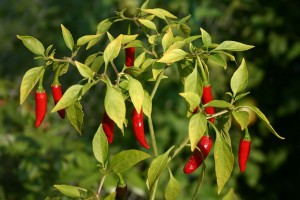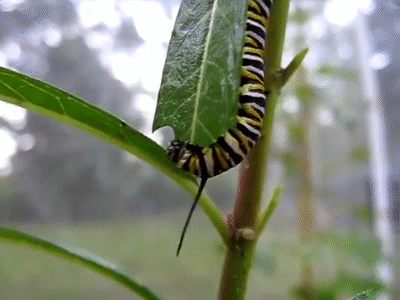Plants are More Into Insect Music Than Ours

G. (2006, May 15). Music for Your Plants [Digital image]. Retrieved May 17, 2016.
Pollinators
An intriguing example of plants visibly reacting to sound/vibration can be found in their relationships with pollinators. The hum created by a bee’s wings creates a very specific pitch, which is sensed by certain flowers, such as those of a tomato plant, or the Orphium frutescens (1). These flowers release their pollen when they feel the bee’s vibration so it can be more sure to attach to the bee, increasing the chance of reproduction. Although this seems less fun than the idea of a plant actually dancing to music, it does have some interesting implications that may lead us to create some bio-mimicked music that plants actually could jam to!
Pests
Another very opposite way that plants respond to vibrations is actually to ward off insects. When a cabbage butterfly caterpillar chews on an Arabidopsis thaliana leaf, the plant recognizes the feeling. At this point, the Arabidopsis releases a toxin (anthocyanin, a water-soluble vacuolar pigment) to get rid of the chewers. BUT, when a gentle breeze or a different insect create a similar vibration, the plant is oblivious and releases nothing. For this reason, this mechanism isn’t yet fully understood (2).
Neighboring Plants

Daniel Risacher (20 July 2004) Thai peppers. Retrieved May 22, 2016.
It has been claimed that plants can actually also use sound to communicate with one another, as is evidenced by the relationship between chilli and fennel. Fennel plants excrete chemicals that halt the growth of surrounding plants. This phenomenon is called allelopathy. They also coincidentally create a certain vibration with their roots as they grow. When fennel is grown in a box next to a chilli plant, even though the fennel’s chemical can’t reach the chilli through the box, sound can still penetrate, and the chilli grows leaning away from the fennel. Botanists believe that chilli plants may be able to hear the vibration created by fennel roots, hence the growing in the opposite direction (3). This could mean that plants are basically talking to each other all over the place, all the time, and we’d have no idea. Some botanists, such as Dr. Monica Gagliano, think plants could use sound to communicate through fungal connections underground, allowing an entire forest to be on the same page; like an internet for plants (4).
There are probably all kinds of mechanisms that plants have evolved with sound that we still haven’t discovered, so keep your ears open!
- S. (2012). Bee hits note to unlock flower pollen. Retrieved May 10, 2016.
- Poecke, R. M., & Dicke, M. (2004). Indirect Defence of Plants against Herbivores: Using Arabidopsis thaliana as a Model Plant [Abstract]. Plant Biology, 6(4), 387-401. doi:10.1055/s-2004-820887
- Gagliano, M., Renton, M., Duvdevani, N., Timmins, M., & Mancuso, S. (2012). Out of Sight but Not out of Mind: Alternative Means of Communication in Plants.PLoS ONE, 7(5). doi:10.1371/journal.pone.0037382
- Oskin, B. (2013, March 11). Sound Garden: Can Plants Actually Talk and Hear? Retrieved May 10, 2016.
- Kim, M. (2014, July 6). Can plants hear? In a study, sound vibrations prompt some to boost their defenses. Retrieved May 10, 2016.
- Hamilton, E. (2015, April 14). Listening in on Plant Defenses. Retrieved May 10, 2016.



